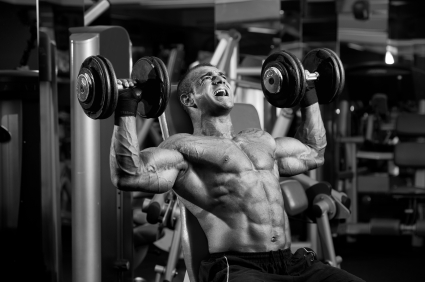We have talked about the permission to be light a lot lately, especially it comes up in the interviews, because guys are starting to realize that being 200 pounds might not be the answer to a great looking body. You would have to be about 6’2” and train for at least 10 years in order to be lean and ripped at 200 pounds, that’s just how it is, no one will tell you this, but height is an important factor in determining your weight.
Today, we are going to discuss something similar, yet different. We won’t talk about the ideal physique, but rather about the training itself that will be responsible for building you such a physique.
If you have been listening to the last couple of interviews you may have noticed that more and more guys are starting to focus on things like
- Training rather than on the supplements
- Workout structure rather than on the high protein diets
- Mind-muscle connection and muscle contraction rather than on the amount of weight lifted
And this goes completely against the conventional saying: “lift heavy, sweat blood in the gym, take protein shake exactly 3.8 minutes after your workout followed by post-workout meal 30 minutes after that”.
Well, Adonis Index made it’s name on going against the conventional approach. However, it’s also made it’s name on having a string of dozens of successful transformations from guys having 4 kids and 4 jobs or guys with injuries lasting decades, yet despite their condition or lifestyle circumstances or training history, they still achieved their physique goals and honed in on their ideal body shape. And more and more of them as they progress are focusing on this unconventional training approach.
The headline of this article is to lift light. And let’s be honest that just doesn’t sound all that sexy, does it? Chances are this would not get printed in a fitness magazine, yet if you get this concept it might be the difference between gaining 8 pounds compared to 3 pounds of muscle mass in the same time period.
What’s the deal with this mind-muscle connection and workout structures anyway, why can’t you just lift heavy to grow more muscles?

Is your training just about lifting heavy or are you really training your muscles and focusing on the contraction?
Well, the truth is that a fare amount of guys that try to lift really heavy, thinking that’s the way to go, experience a loss in their strength.
Have you ever done a really tough workout, but instead of just feeling sore, you felt really weak for several days? Or you may have just noticed that your strength decreased over a couple of weeks.
Well, if that happened to you, you may count yourself lucky, because you could have also seriously injured yourself.
I’ve even seen some serious chest tendon injuries as an immediate result of heavy bench press and testing the “max”.
Let me tell you something, if you are a guy that can’t do a bench press without someone else helping you with the bar and your whole body is shaking and almost dancing on the bench while you are lifting the bar up, you may want to reconsider your training style. Not only that your friend can do a biceps curl on his own without you lying under the bar, but you alone are not training instead you’re simply stroking your ego by attempting to lift more weight than your current body can.
Best case scenario – you will simply just look dumb, worst case scenario – you will get injured and won’t be able to work out for months or years.
Not only that lighter weights are bearable on your joints and CNS, but with lighter weights you can do something that you just can’t with the heavy weights.
What it is?
Well, you can actually focus on TRAINING the muscle.
If you are lifting so much that you are only thinking about putting the bar down after the first two reps, you are not really training.
Workout Structure Should Dictate the Resistance
What really drives me nuts, well apart from the whole fitness industry, is when somebody comes up to me and says: “Hey how much do you lift on bench press?” or “How strong are your biceps?”. This just doesn’t make sense and just shows that you have no idea what you are talking about if you ask a question like that.
Most people do the 3 set-8 reps-rest until fresh type of training that they’ve heard the first day of their workout life from some trainer. Some people will do that for the rest of their lives.
The truth is that there is no universal way to train, every workout type is different, so asking about the weight without mentioning the other variables of your training is kind of short sighted.
If you asked me how strong I was in the middle of the 2nd workout in the week 7 of the IXP on my biceps, then I would tell you. However, this is a completely different question, you are being specific and we both know what type of training structure are we talking about.
Let’s elaborate on this a bit.
If you do the regular Adonis Index Workout, then most of your training will be around 5,8 and 13 reps with around 90 or 120 seconds rest. However, if you decided to follow the IXP protocol, you may be doing three supersets in a row with no rest in between. So, this means 6 sets in a row, back to back, no rest. Do you think that you can lift the same weight in both of those training protocols in a given exercise?
Of course not.
Just like with look, weight itself tells nothing, because it’s all about proportions and shape, and the same applies here. If you said just how much you lift, you gave a number that holds no meaning, because nobody would know whether you did 3 reps or 21. And that’s a pretty big difference. Not speaking of the fact that in that given workout day, you may have been doing the exercise as a first one, while normally you do it as a last.
Here is test for you.
Take one routine you normally do, change nothing, just add three sets of 10 reps with 90 sec rest of pull-ups. In the first week, do this exercise as the first exercises of the day, so before you start your regular routine. Next week once you are fully recovered, do the same routine, but this time do the pull-ups as the last exercise, after the your routine.
You see where we are going with this?
There is just so many variables that will translate into you changing weights all the time on the same exercises.
Here is a short list of the stuff that will dictate how heavy you will be able to go:
- Sets, reps done in the exercise (3×21 vs 6×6)
- Rest after each set (30 sec vs 90 sec)
- Regular sets vs Supersets vs Pyramids and other types
- Frequency of your workouts and frequency of you training each muscle group
- The sequence in which you will do the exercises in your workout
- Sleep – how much you got the night before, the quality of that sleep
There might be a few others, but the point is to show you, that it’s important to detach yourself from the number on the plate or on the dumbbell and choose based on your workout structure.
A smart choice of the weight will help you stay away from injury and allow you to train your muscles properly. Which brings us to the last part of today’s lesson.
You Can’t Expect Your Muscles to Grow from Lifting
Not only that most guys believe that protein intake is the trigger for muscle growth, but they also think that the lift itself gives your muscles incentive to grow.
Well, not really. Your muscles don’t know how much you lift, what workout you use, how many reps you do, only your mind does.
The only thing your muscle feels is the repeated contraction against greater resistance, which makes it grow.
Big difference.
So, next time you are in the gym, make sure you don’t pick the heaviest dumbbells in there, thinking how amazingly strong you are going to look to everyone around you, but pick a reasonable one and focus on doing the motion with perfect form and really feeling the muscle contracting and working.
If you apply this advice you should see results in both strength and look.
Summary of Today’s Lesson:
- Leave your ego out of this, preferably at the gym’s entrance
- Try to detach yourself from the numbers on the plates and focus on feeling the muscle working rather then lifting some specific weight
- Realize that muscles grow not because of protein intake or weight lifting, but because you are repeatedly creating strong contraction against greater resistance…weights are just a tool to create resistance
- Understand that there are different workout structures and they will determine how heavy will you be able to go
- Focusing on mind-muscle connection, feeling the muscle, contracting it in the fullest way possible is way more important than lifting the heaviest weights you can manage…form ALWAYS trumps weight…ALWAYS
- Try several different workouts like AI 3.0, ATS or IXP to understand this concept in more detail, you will learn all this by experience
- There is a difference between lifting and training, ask yourself: “Do I want to be a weight lifter or be in killer shape, what’s more important for me?” and act accordingly
- Of course you still need to lift a reasonable amount of weight, doing curls with pencils will not get you anywhere (I know, stupid, but had to be said)
Talk to you soon,
Vaclav Gregor
